- Home
- Robert J. Sawyer
Hybrids Page 10
Hybrids Read online
Page 10
“I would have thought this was a routine operation,” said Mary.
Korbonon’s eyebrow was a light reddish blond. It rose. “Routine? Not adding a first Companion to an adult arm. Of course, when the Companions were introduced, almost a thousand months ago, they were mostly installed in adults-but the surgeons who did that then are all long dead. No, this operation has only been occasionally performed since, mostly on those who have lost the arm that contained the implant they received in childhood.”
“Ah,” said Mary. She was leaning back in something that vaguely resembled a dentist’s chair with stirrups-apparently an all-purpose operating platform. Her left arm was sitting on a little table that protruded from one side of the chair. The inside of her arm had been swabbed with something that wasn’t alcohol-it was a pink liquid that smelled sour, but apparently served the purpose of disinfecting the skin. Still, Mary was surprised to see that Korbonon wasn’t wearing a face mask. “Our surgeons usually cover their noses and mouths,” said Mary, a bit concerned.
“Why?” asked Korbonon.
“To keep them from infecting the patient, and the patient from infecting them.”
“I might as well operate blindfolded!” declared Korbonon.
Mary was about to question the statement, then realized what the surgeon meant: the acute Neanderthal sense of smell provided a crucial part of their perception.
“What will you do about anesthetic?” asked Mary. For the first time, she was grateful that Ponter wasn’t here. Knowing his sense of humor, he would have doubtless quipped, “Anesthetic? What is that?”-to be followed, of course, after a suitable pause, with “Just kidding.” She was nervous enough as it was.
“We will use a neuronal interrupter,” replied Korbonon.
“Really?” said Mary, the scientist in her coming to the fore, despite her apprehension about the operation. “We use chemical agents.”
The surgeon nodded. “We used to do that,” she said, “but they take time to become effective, time to wear off, and are difficult to localize precisely. Also, of course, some people have allergies to chemical anesthetics.”
“Yet another technology my people will doubtless want to trade for,” said Mary. A second female loomed in-Mary didn’t know anything about Barast medical hierarchies; she might have been a nurse or another doctor, or held some position that had no counterpart in the Gliksin world. In any event, she wrapped an elastic metalized band around Mary’s left forearm just below the elbow, and then attached another one just above the wrist. Then, to Mary’s astonishment, she took out what looked like a fat Magic Marker, and started drawing a complexseries of lines between the two bands. Rather than ink, though, what looked like liquid metal came out. But it wasn’t hot, and it quickly dried, gaining a matte finish as it did so. The color was wrong, but the effect was like that chocolate syrup for ice cream that hardens quickly into a crust. “What are you doing?” asked Mary.
The Barast with the marker made no reply. But the surgeon said, “She is tracing the appropriate nerve trunks in your forearm. The lines form electrical connections between the two destabilizers.”
After a few minutes, the second female nodded, apparently to herself, and moved away, approaching a small control console. She pulled out a series of control buds, and Mary felt her forearm go numb. “Wow,” she said.
“All right,” said Korbonon. “Here we go.” And before Mary knew what was happening, the surgeon had dived in and made a long incision parallel to Mary’s radius. Mary almost threw up as her own blood welled out, spilling onto the little table, which she now noted had a raised lip all around its edge.
Mary was shocked-and was worried about goinginto shock. In her world, great efforts were taken to keep patients from being able to see themselves during surgery. But here, no thought had been given to that. Maybe having to kill your own food, even occasionally, was enough to put an end to such squeamishness. Mary swallowed hard and tried to calm herself; it really wasn’tthat much blood...was it?
She wondered what happened during thoracic surgery. Gliksin surgeons were presented with a patient whose face was covered, and had only a tiny, exposed surgical field. Did the Barasts do it that way, too? The main reason, after all, wasn’t to keep the patient from getting covered with blood. Rather, Mary had been told by one of her doctor friends, it was a psychological aid for the surgeon-a way of keeping him or her focused on the problem in cutting and splicing, rather than thinking of themselves as carving into the home of another human soul. But the Barasts, with their complete lack of Cartesian duality and their indifference to gore, perhaps had no such need.
Korbonon slipped several blue springlike things into the wound that apparently did the same job as forceps, holding it open. Other little clips and doodads were attached to arteries, veins, and nerves. Mary could clearly see into the opening in her skin, cutting through fat and meat all the way down to the slick grayish solidity of her radius.
Moments later, the other Barast-the one who had painted the nerve-deadening lines on Mary’s forearm-moved in. The Barast doctors were wearing short-sleeved yellow shirts and long blue gloves that went past their elbows; Mary thought perhaps they went that high to keep blood from getting matted into their hairy forearms.
The second Barast picked up Mary’s new Companion and removed it from its sterile wrapping. Mary had gotten used to the look of the faceplates, but had never seen the other side of one. It was sculpted like a topographic model, with highs, lows, and channels, presumably to accommodate blood vessels. Mary watched in queasy fascination as her own radial artery-the suicide’s favorite-was severed. It was quickly clamped at both ends, but not before a tube of blood a foot long had shot out.
Mary winced, wondering how Vissan Lennet, the creator of the codon writer, had managed to self-perform the removal of her Companion; it must have been horrendously difficult.
The surgeon next used a laser scalpel, similar to the one Mary herself had had to use when Ponter was shot outside the United Nations. The two ends of Mary’s radial artery were attached to two different apertures on the underside of the Companion. She knew the Companions had no power source of their own; they were fueled by bodily processes. Well, the pumping strength of blood through the radial artery was certainly a good source of power; apparently the Companion had a hydroelectric-or would that be sanguinoelectric?-generating plant built in.
Mary kept meaning to turn away-just as she always quickly hustled past the TV seriesThe Operation on The Learning Channel when surfing. But it really was interesting in an awful sort of way. She watched as the Companion installation was completed, the blood vessels cauterized, and her skin sealed by minute laser blasts. Finally a puttylike caulking was extruded all around the edges of her Companion, apparently to promote healing.
By comparison, the remaining surgery-inserting the two cochlear implants-was minor, or so it seemed, although that might have just been a consequence of Mary being unable to see that part of the operation.
At last, it was all done. Mary’s arm had been wiped clean of blood, the protective film had been removed from the Companion’s faceplate, and the cochlear implants had had their output balanced and tuned.
“All right,” said the surgeon, reaching down to Mary’s forearm and pulling out a small beadlike control bud, one of six, each a different color. “Here you go.”
“Hello, Mary,” said a synthesized voice. It sounded as though it were coming from the middle of her head, exactly between her ears. The voice was Neanderthaloid-deep, resonant, probably female-but it managed theee phoneme in Mary’s name perfectly; clearly, that problem had been addressed and solved.
“Hello,” said Mary. “Um, what should I call you?”
“Whatever you wish.”
Mary frowned, then: “How about Christine?” Christine was Mary’s sister’s name.
“That’s fine,” said the voice in her head. “Of course, if you change your mind, you’re free to rename me as often as you like.”
“Yes.”
Mary made an impressed face. “So you can use contractions! Ponter’s Companion can’t.”
“It wasn’t a difficult programming issue,” said Christine, “once the underlying concept was grasped.”
Mary was startled by a tap on her shoulder. She’d blanked out the exterior world while talking with the Companion; she wondered if she had tilted her head the way Neanderthals routinely did-whether that was something that happened naturally, or was a learned behavior, a courtesy to let others know that you were momentarily preoccupied.
“So,” said the surgeon, smiling down at Mary, who was still seated in the operating chair. “I take it your Companion is working?” For the first time, Mary heard a translation the way Ponter did-not through an external earpiece, but as words flowering full-blown in her head. The Companion was a good mimic; although the English words were emphasized at bizarre points-as if William Shatner were saying them-they were presented in a voice much like the surgeon’s own.
“Yes, indeed,” said Mary-and as soon as she’d finished, her Companion’s external speaker announced what Mary recognized as the Neanderthal equivalent: “Ka pan ka.”
“All right, then,” said the woman, still smiling. “That’s it.”
“Is my Companion transmitting to my alibi archive?”
“Yes,” replied the surgeon, and “I am,” said Christine in her own voice after translating the surgeon’s “Ka.”
Mary got out of the chair, thanked the surgeon and her colleague, and headed on her way. When she came to the medical facility’s lobby, she saw four male Neanderthals, each of which seemed to have a broken arm or leg. One was dressed in the silver of an Exhibitionist. Mary figured such a person wouldn’t be offended by questions, so she walked up to him and said, “What happened?”
“To us?” asked the Exhibitionist. “Just the usual: hunting injuries.”
Mary thought of Erik Trinkaus and his observation that ancient Neanderthals often had injuries similar to those of rodeo riders. “What were you hunting?”
“Moose,” said the Exhibitionist.
Mary was disappointed that it wasn’t something more exotic. “Is it worth it?” she asked. “The injuries I mean?”
The Exhibitionist shrugged. “Getting to eat moose is. There’s only so much passenger pigeon and buffalo you can take.”
“Well,” said Mary, “I hope they get you all fixed up quickly.”
“Oh, they will,” said the Exhibitionist with a smile.
Mary said goodbye and left the hospital, going out into the late-afternoon sun; she’d probably given the Exhibitionist’s audience quite a treat.
And then it hit her: she’d just entered a room that contained four males she’d never met, and rather than being terrified, as she would have been back on her world even after learning the identity of her rapist, she hadn’t felt any apprehension. Indeed, she’d brazenly walked over to one of the men and struck up a conversation.
She looked down in wonder at her forearm, at her Companion, at Christine. The notion that everyone’s activities were being recorded hadn’t seemed real until her own permanent Companion had been made part of her. But now she understood howliberating it was. Here, she was safe. Oh, there might still be lots of people of ill will around her, but they would never try anything...because they could never get away with anything.
Mary could have had Christine call for a travel cube to take her back to Lurt’s house, but it was a lovely fall day, and so she decided to walk. And, for the first time on this world, she found herself easily meeting the eyes of other Neanderthals, as though they were her small-town neighbors, as though she belonged, as though she were home.
Chapter Fifteen
“There are human footprints preserved in volcanic ash at Laetoli, made by a male and a female australopithecine, the ancestors to both Gliksins and Barasts, just wandering, walking slowly, side by side, exploring: the original small hominid steps. And there are human footprints at Tranquility Base and the Ocean of Storms and Fra Mauro and Hadley Rille and Descartes and Taurus-Littrow on the moon-truly giant leaps...”
Mary was exhausted from the surgery, and when she arrived at Lurt’s house, she simply went to sleep, having a long nap on the recessed square filled with cushions that served as her bed. She didn’t wake until Lurt got home from her lab two daytenths later.
“See!” said Mary, showing off her new Companion.
Almost all Companions looked the same, but Lurt evidently detected that Mary wanted a compliment. “It’s lovely,” she said.
“Isn’t it, though?” said Mary. “But it’s not an it; it’s a she. Her name is Christine.”
“Hello,” said the synthesized voice from Christine’s speaker.
“Christine,” said Mary, “this is Scholar Lurt Fradlo. She is the woman-mate of Scholar Adikor Huld, who is the man-mate of my...” Mary halted, looking for the correct word, then, with a shrug, continued: “...of my boyfriend, Scholar-and Envoy-Ponter Boddit.”
“Healthy day, Scholar Fradlo,” said Christine.
“Healthy day,” replied Lurt. “You may call me Lurt.”
“Thank you,” said the Companion.
Lurt took a deep breath, apparently inhaling scents. “Ginrald is not home yet,” she said. Ginrald was Lurt’s woman-mate.
“No,” said Mary. “Nor is Dab or Karatal.” Dab was Lurt’s young son by Adikor Huld; Karatal was Ginrald’s young daughter by her own man-mate.
Lurt nodded. “Good. Then perhaps we can talk. There is a circumstance we must resolve.”
“Yes?”
But then Lurt remained silent, apparently reluctant to go on.
“Have I done something wrong?” asked Mary. “Have I offended you somehow?” She knew being in this world would be fraught with cultural difficulties, but she’d tried hard to follow Lurt’s lead in everything.
“No, no,” said Lurt. “Nothing like that.” She gestured for Mary to have a seat in the circular living area. Mary moved to the couch, and Lurt straddled a nearby saddle-seat. “It’s simply a question of your living arrangements.”
Mary nodded. Of course. “I’ve overstayed my welcome,” she said. “I’m sorry.”
Lurt raised a large hand, palm out. “Please don’t misunderstand. I enjoyed your company on your previous visit greatly. But my home is already crowded. Granted, Dab will leave us in a couple of tenmonths to go live with Ponter and Adikor, but...”
Mary nodded. “But that’s in a couple of tenmonths.”
“Exactly,” said Lurt. “If you’re to spend much time in this world, you must have your own home.”
Mary frowned. “I have no idea how to do that. And I’ll have to talk to Ponter. It’s one thing to have his account debited for my incidentals, but if I’m going to buy a house-“
Lurt laughed, but it wasn’t derisive. “You don’t buy a house. You select one that’s vacant and occupy it. Your contribution is unquestioned; you have brought much new knowledge to us. You are certainly entitled to a house.”
“You mean houses aren’t privately owned?”
“No. Why would they be? Ah, I think I see. Remember, we have a stable population size. There is no need for new houses, except to replace those trees that ultimately die. And trees for houses are planted and tended by the government, since, after all, it’s a long time before they’re big enough to be occupied. But there are always some surplus ones, to accommodate temporary visitors to Saldak. We can find you one of those. I know an excellent carpenter who can make furniture for you-I rather suspect she would enjoy the challenge of accommodating your particular needs.” Lurt paused for a moment. “Of course, you would be living alone.”
Mary didn’t want to say that would be a relief-but, in fact, she was used to being on her own. In the years since she and Colm had split, Mary had gotten to quite enjoy her quiet evenings at home. In comparison, the
hustle and bustle of Lurt’s household had been nerve-wracking. And yet-
And yet, this world was sostrange . Mary was nowhere near ready to deal with it without assistance. Even with the aid of Christine, she knew she was still in way over her head.
“Do you perhaps have a friend who could use a roommate?” asked Mary. “You know, someone who is alone, but might enjoy sharing household duties for a while with another?”
Lurt tapped her thumb against the center of her forehead, just above where the twin arches of her browridge joined. “Let me think...Let me think...” But then she tipped her head, clearly listening to a suggestion from her own Companion. “That’s an excellent idea,” she said, nodding. She looked at Mary. “There is a woman named Bandra Tolgak who lives not far from here. She is a geologist, and one of my favorite people. And she’s absolutely fascinated by Gliksins.”
“And she doesn’t have a family living with her?”
“That’s right. Her union with her woman-mate dissolved some time ago, and both of Bandra’s children have left home now-her younger daughter just recently. She’s mentioned how empty her house seems; perhaps she might be amenable to an arrangement...”
It was a cool fall day, with cirrus clouds finger-painted on a silvery sky. Lurt and Mary walked along. Ahead was a building about the width of a football field and, judging by the deployment of windows, four stories tall. “This is our Science Academy-the one for women,” said Lurt. “Bandra Tolgak works here.”
They came to one of many doors-solid, opaque, hinged. Lurt opened it, and they continued down a corridor, square in cross section, light provided by catalytic reactions inside tubes set into the walls. Many female Neanderthals of generation 147-the right age for a university education-were milling about, and a variety of spindly robots were zipping to and fro, running errands. Lurt stopped when they came to the station for a pair of elevators. Neanderthals, very sensibly, left their elevator doors open when idle, keeping the cabs from getting stuffy and making it obvious at a glance when one was available on the current floor. Lurt led Mary into the one that was waiting. “Bandra Tolgak’s lab,” Lurt said into the air. The doors closed, and the elevator began moving upward. After a few seconds, the doors reopened, and they were looking out into another corridor. “Third door on your right,” said a synthesized voice.

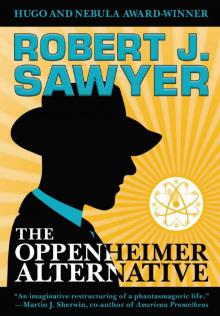 The Oppenheimer Alternative
The Oppenheimer Alternative Factoring Humanity
Factoring Humanity The Shoulders of Giants
The Shoulders of Giants Stream of Consciousness
Stream of Consciousness End of an Era
End of an Era The Terminal Experiment
The Terminal Experiment Far-Seer
Far-Seer Mindscan
Mindscan You See But You Do Not Observe
You See But You Do Not Observe Star Light, Star Bright
Star Light, Star Bright Wonder
Wonder Wiping Out
Wiping Out Flashforward
Flashforward Above It All
Above It All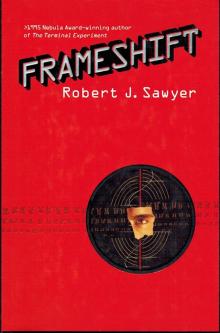 Frameshift
Frameshift The Neanderthal Parallax, Book One - Hominids
The Neanderthal Parallax, Book One - Hominids Foreigner
Foreigner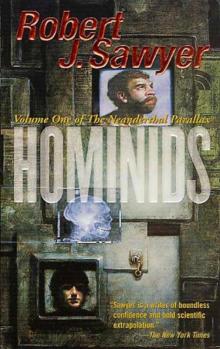 Neanderthal Parallax 1 - Hominids
Neanderthal Parallax 1 - Hominids Relativity
Relativity Identity Theft
Identity Theft Hybrids np-3
Hybrids np-3 Foreigner qa-3
Foreigner qa-3 WWW: Watch
WWW: Watch Calculating God
Calculating God The Terminal Experiment (v5)
The Terminal Experiment (v5) Peking Man
Peking Man The Hand You're Dealt
The Hand You're Dealt Illegal Alien
Illegal Alien Neanderthal Parallax 3 - Hybrids
Neanderthal Parallax 3 - Hybrids Fossil Hunter
Fossil Hunter WWW: Wonder
WWW: Wonder Iterations
Iterations Red Planet Blues
Red Planet Blues Rollback
Rollback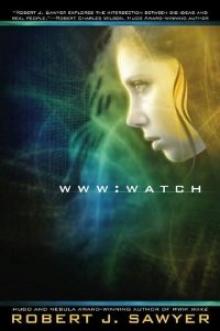 Watch w-2
Watch w-2 Gator
Gator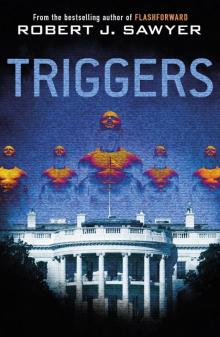 Triggers
Triggers Neanderthal Parallax 2 - Humans
Neanderthal Parallax 2 - Humans Wonder w-3
Wonder w-3 Wake
Wake Just Like Old Times
Just Like Old Times Wake w-1
Wake w-1 Fallen Angel
Fallen Angel Hybrids
Hybrids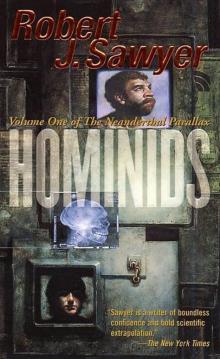 Hominids tnp-1
Hominids tnp-1 Far-Seer qa-1
Far-Seer qa-1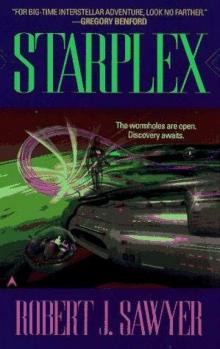 Starplex
Starplex Hominids
Hominids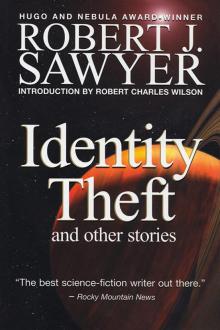 Identity Theft and Other Stories
Identity Theft and Other Stories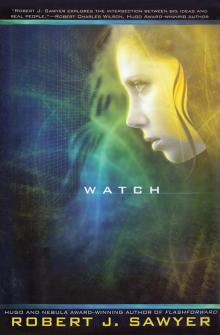 Watch
Watch Golden Fleece
Golden Fleece Quantum Night
Quantum Night Fossil Hunter qa-2
Fossil Hunter qa-2 Humans np-2
Humans np-2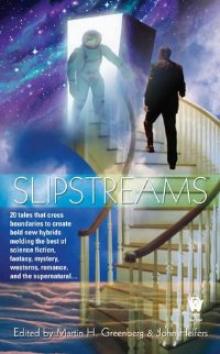 Biding Time
Biding Time